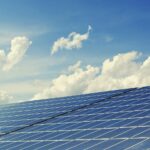Passive and Active Solar Systems: What Sets Them Apart?
The modern era has witnessed a surge in the demand for sustainable energy solutions. Two prominent players in this transition are passive and active solar systems. While both harness the sun’s abundant energy, their methods and mechanisms are markedly different. This review delves deeper into their similarities and differences, providing insights for potential adopters.
1. Fundamental Similarities
- Sustainability and Eco-friendliness: At their core, both passive and active solar systems prioritize sustainability. They are champions of green energy, diverting us from fossil fuels and consequently reducing the carbon footprint;
- Solar Dependence: Regardless of their modus operandi, both systems are dependent on sunlight. Their efficiency can fluctuate based on geographical location, seasonal variations, and daily weather patterns;
- Energy Reduction: Both systems, when efficiently implemented, can significantly reduce or even eliminate the need for traditional energy sources, leading to cost savings in the long run.
2. Operational Differences
Mechanism:
- Passive Solar: The passive system is the epitome of simplicity, leveraging building design to naturally capture, store, and distribute solar heat. Think of south-facing windows, thermal walls, or floors that store heat during the day and release it at night;
- Active Solar: In contrast, active systems are technologically advanced, relying on devices like solar panels to capture and convert solar energy into electricity or heat. They might also employ pumps or fans to distribute this energy.
Application Scope:
- Passive: Passive solar designs are often incorporated during a building’s construction phase. Retrofitting an existing structure to fully adopt passive solar principles can be challenging;
- Active: These systems are more versatile in terms of application. Whether it’s a brand-new structure or a century-old building, active solar devices like solar panels can typically be installed.
3. Economic Implications
Initial Expenditure:
- Passive: Incorporating passive solar design might inflate initial building costs. However, these costs are often offset by reduced energy bills over time;
- Active: Active systems, especially photovoltaic installations, can be capital-intensive initially. But advancements in technology and economies of scale are gradually bringing down these costs.
Maintenance Costs:
- Passive: Given its lack of moving parts or complex systems, passive solar typically demands negligible maintenance;
- Active: Active systems can incur maintenance costs. Solar panels might need occasional cleaning, and components like inverters might require replacement after a decade or so;
- Return on Investment: Both systems offer substantial returns over time. However, active systems, particularly with government incentives or rebates, can often provide a quicker return on investment.
4. Performance and Efficiency
Consistency:
- Passive: The performance of passive systems can be remarkably consistent, provided the building’s design is optimized for its geographical location. Once set, there’s little variability unless there are structural changes;
- Active: While generally efficient, active systems can experience fluctuations. Solar panels, for instance, can be affected by debris or snow coverage.
Adaptability:
- Passive: Modifying a passive solar design post-construction can be cumbersome and costly;
- Active: Active systems offer more adaptability. For instance, one can expand a solar panel array with growing energy needs.
5. Integration and Aesthetics
- Passive Systems: These are usually seamlessly integrated into a building’s architecture. When done right, passive solar designs can enhance a structure’s aesthetic appeal, with large windows or atriums serving both functional and decorative purposes;
- Active Systems: While the sleek look of solar panels is becoming more accepted and even admired, some might find them obtrusive. However, innovations like solar shingles are blurring the lines between functionality and aesthetics.
The Impact on the Environment
Ah, the wonders of solar energy! Here’s an attempt: Solar? A blessing for our dear Mother Earth. Imagine: vast fields devoid of trees, replaced by belching factories, all to sustain our never-ending thirst for power. Yet, behold! A shimmering solution: passive and active solar systems. Not only do they whisper a soft “no” to our crippling reliance on coal and oil, but they sing praises of cleaner air and untouched habitats. And pollutants? Dramatically diminished.
Passive solar – a marvel in itself. Its intricate design dances to a tune of maximum efficiency, ensuring every glint of sunlight is cherished, not wasted.
Then, let’s talk active solar. It’s not just about meeting needs, but about abundance. Picture this: Your house, not just a dwelling, but a beacon of energy. Sometimes it even pours its heart out, giving back to the grid. An act of kindness. A gift. That excess? It’s shared, and like a cup of sugar borrowed from a neighbor, it eases the burden on those old, smoke-spewing plants. Emissions? Reduced. The future? Brighter.
Technological Innovations and Future Prospects
Ah, solar energy – a realm that never stands still, ever dynamic, a dance of photons and potential. Picture this: as the sands of technology’s hourglass flow unceasingly, active solar systems are on a meteoric rise, achieving feats that once lay solely in the domain of imagination. Have you heard of bifacial solar panels? These wondrous creations greedily lap up sunrays from not just one, but both their faces! And then, there’s the solar tracking system, an intricate ballet where panels, like sunflowers, chase the golden orb across the sky, maximizing every drop of sunlight.
But don’t let active solar systems steal the entire limelight. Passive designs, often overshadowed, are having their moment in the sun, quite literally. The unsung heroes of material science have been toiling away, gifting us materials that are nothing short of revolutionary. Think materials with the might of giants, holding onto heat with the tenacity of a vice grip, or those with insulating talents that would put the fluffiest of duvets to shame.
In this confluence of art, science, and design, what becomes evident is this: the solar narrative is not merely about a bright tomorrow. No, it’s about a world where solar doesn’t just coexist but thrives, becoming more attuned, streamlined, and oh-so-convenient for every Jane and John Doe. The sun is shining, and it’s time we basked in its glory!
Conclusion
Choosing between passive and active solar systems (or deciding to integrate both) requires careful consideration of multiple factors: the available budget, the intended purpose (heating, electricity, or both), the nature of the structure (new or existing), and long-term goals.
The beauty of solar energy is its versatility. Passive systems showcase how intuitive design can synchronize with nature, minimizing energy needs. On the other hand, active systems exemplify human ingenuity, converting sunlight directly into usable energy with the help of technology.
Both passive and active solar systems signify a step towards a more sustainable and eco-friendly future. As technology advances and our understanding of sustainable design deepens, the divide between them might blur, leading to hybrid solutions that offer the best of both worlds.









